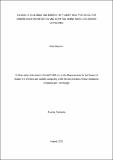| dc.description.abstract | In recent years, wireless sensor networks have been widely applied in agricultural greenhouses
to monitor and control farming-related parameters. These networks are composed of multiple
sensor nodes, usually deployed in an ad hoc fashion. This form of farming attains the best
quality and crop yield. However, the sensor nodes are energy constrained. So it is essential to
reduce node power consumption to extend the network lifetime. An extensive analysis of
weather conducted at Tanzanian locations show that weather parameters do not vary frequently.
These characteristics motivate a duty cycling strategy, to minimize node power usage and
increase the network lifetime. Therefore, this work proposes Greenhouse Sensor MAC (GS-
MAC), a medium-access-control (MAC) protocol designed for greenhouse monitoring and
control: energy conservation and scalability are the primary objectives, with latency being less
crucial. To minimize idle listening, nodes implement a Time Division Multiple Access
(TDMA) scheme and periodically sleep. Nodes in close proximity organize into clusters.
Unlike traditional duty cycling techniques, GS-MAC avoids periodic node synchronizations.
Instead, nodes communicate by maintaining strict schedules provided by cluster heads, to avoid
collisions, over-emitting and minimize the duty cycle. GS-MAC also uses short node addresses
to reduce packet overheads. Finally, GS-MAC adopts a contention approach on reserved time
slots allocated between communication rounds to maintain scalability. GS-MAC has been
implemented on MATLAB software, with simulation parameters (i.e., sensor nodes' current
consumption characteristics) obtained from actual hardware. The experiment results show that
GS-MAC extends the network lifetime by at least 2.7 times more than previous research, with
traffic loads sent every 1-60 seconds | en_US |

